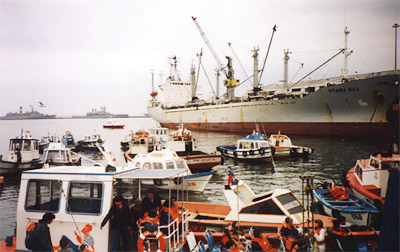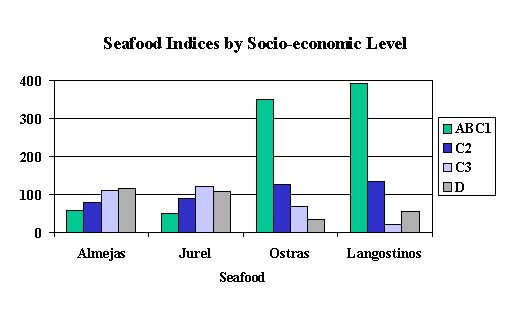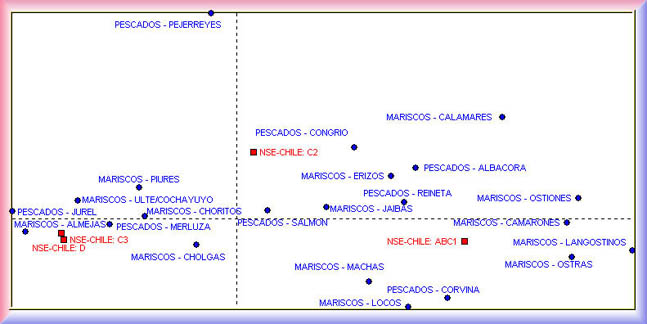
Viña del Mar, Chile (photo credit: Deborah Levy)
Eating Seafood in Chile
Necesito del mar porque me enseña:
no sé si aprendo música o conciencia:
no sé si es ola sola o ser profundo
o sólo ronca voz o deslumbrante
suposición de peces y navíosEl Mar, Pablo Neruda
Chile is a country that is 24 times longer than it is wide (more precisely, 4270 kilometers long and 177 kilometers across on the average), with the Pacific Ocean running down the western side. Due to the cold Humboldt Current that runs from the Antarctic Ocean up along the Chilean coastline northwards, there is an abundant fishstock, making the fishmeal industry one of Chile's largest export earners. This is also means that seafood is a popular staple in the meals of Chileans.

Viña del Mar, Chile (photo credit: Deborah Levy)
We will show some data about seafood consumption among Chileans from the 1999 TGI Chile study. This is a survey of 2,003 persons between the ages of 12 and 64 living in the Gran Santiago area. In the survey, the respondents were asked to indicated whether or not they frequently ate certain types of seafood. In the table below, we show the results for twenty different types of seafood.
% persons who frequently ate seafood
| Seafood | % persons ate frequently |
| Merluza (hake) | 37% |
| Almejas (clams) | 23% |
| Reneita (pippin) | 22% |
| Choritos (sea barnacles) | 21% |
| Jurel (mackerel) | 11% |
| Salmon (salmon) | 9% |
| Machas (clams) | 7% |
| Congrio (conger) | 6% |
| Cholgas (mussels) | 6% |
| Corvina (corvina) | 4% |
| Jaibas (crabs) | 3% |
| Cochayuyo (seaweed) | 2% |
| Langostinos (prawns) | 2% |
| Locos (abalones) | 2% |
| Erizos (sea urchins) | 2% |
| Ostras (oysters) | 2% |
| Pejerreyes (smelt) | 2% |
| Albacora (swordfish) | 2% |
| Ostiones (scallops) | 1% |
| Calamares (calamaris) | 1% |
(source: TGI Chile, Time IBOPE)
Not all types of seafood are equally popular. The first major reason has to do with the prices for the seafood. Something that is easy to harvest and widely available will be cheaper, and therefore affordable to the majority of the population. Conversely, something that is rare to find will command a premium price. In the case of salmon, they are cultivated on special farms and are therefore costly too. In fact, most of the Chilean salmon is exported to Japan and elsewhere, making Chile the second largest salmon exporter in the world after Norway.
The second major reason has to do with taste. Preferences for various seafood types reflect national, regional, local, class, cultural, religious, ethnic, family, medical and personal customs and traditions. Or, if you agree with Isabel Allende, because they have high aphrodisiac values.
These two reasons also combine to lead to unusual ways in which seafood must be harvested, prepared and eaten. Here is how Isabel Allende described some of them in her remarkable book:
Abalone In Chile we call it loco, maybe because to tenderize it you have to pound it unmercifully, the way mental patients once were treated. It lives in a thick shell, adhered to rocks, usually in cold waters. Harvesting it is not an agreeable task; you have to sink into icy water, equipped with an iron bar to pry the abalone from the rock. There is a science to cooking it, and the person who doesn't it usually ends up gnawing on a piece of hard rubber, but when properly prepared it is delicious.
Shrimps, prawns, crabs, lobsters, and other crustaceans Tasty, decorative, and very aphrodisiac, these are also easy to prepare --- simply boil or broil them --- but sometimes you must have a heart of ice to kill them. To use the example of the lobster: you have to peg and bind its claw and submerse it head first in boiling water, turning a deaf ear to its faint moans, and cook it until the shell turns red. Keeping in mind that some lobsters are the size of a rat, this is not a task recommended for the faint of heart or for maidens.
Oysters Oysters are the queens of aphrodisiac cuisine, protagonists of every erotic scene recorded in literature or on film. The best way to eat them is raw, after squeezing lemon over them to test whether they are alive, because otherwise they are very toxic. The miserable creatures writhe in the acid. The flesh must look firm and plump, creamy in color, and float in a transparent, inoffensive-smelling liquid. If you buy them in their shells, I warn you that opening them takes strength and skill. Buy them already opened or eat them at restaurants, where someone else has been responsible for the work of preparing them.
Given these reasons, we would certainly expect that seafood consumption to differ not so much by demographics such as age and sex, but more so by socio-economic class. In the next chart, we show how the consumption of four types of seafood differ by socio-economic level. The numbers are indices, which is defined as 100 times the incidence percentage in the socio-economic group divided by the incidence percentage in the total population. Thus, almejas (clams) and jurel (mackerel) are more popular among the lower classes, while ostras (oysters) and langostinos (prawns) are much more popular among the upper classes.

(source: TGI Chile, Time IBOPE)
Rather than presenting these charts for each of the twenty types of seafood, we have constructed a correspondence map. This is a geometric representation of the relationship between seafood and socio-economic level. The horizontal dimension clearly reflects the socio-economic dimension, with the upper classes to the right and the lower classes to the left. In this case, what you are influences what you eat.
Correspondence Map of Frequently Consumed
Seafood by Socio-economic Level

(source: TGI Chile, Time IBOPE)
![]()
READING MATERIAL
Isabel Allende (1998) Aphrodite: A Memoir of the Senses. Harper Flamingo: New York.
Qué Pasa, issue # 1383, October 14-20, 1997. Los Afordisiacos de Isabel Allende.
(posted by Roland Soong on 3/02/2000)
(Return to Zona Latina's Home Page)